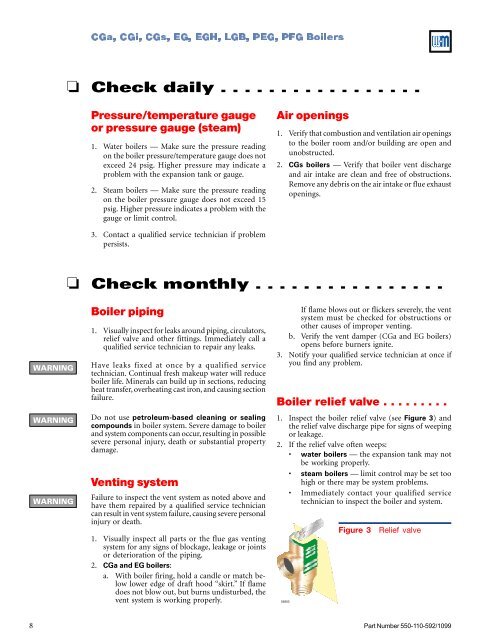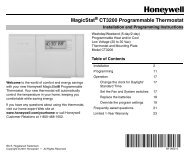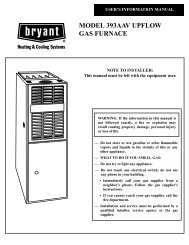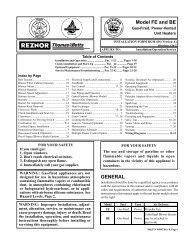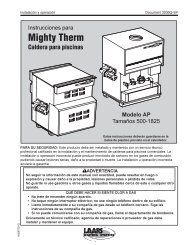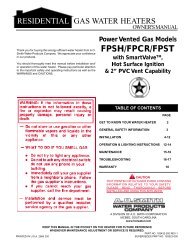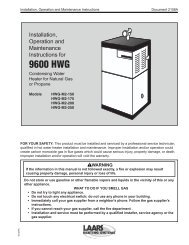CGa, CGi, CGs, EG, EGH, LGB, PEG, PFG - Geisel
CGa, CGi, CGs, EG, EGH, LGB, PEG, PFG - Geisel
CGa, CGi, CGs, EG, EGH, LGB, PEG, PFG - Geisel
Create successful ePaper yourself
Turn your PDF publications into a flip-book with our unique Google optimized e-Paper software.
❏ Check daily . . . . . . . . . . . . . . . . .<br />
Pressure/temperature gauge<br />
or pressure gauge (steam)<br />
1. Water boilers — Make sure the pressure reading<br />
on the boiler pressure/temperature gauge does not<br />
exceed 24 psig. Higher pressure may indicate a<br />
problem with the expansion tank or gauge.<br />
2. Steam boilers — Make sure the pressure reading<br />
on the boiler pressure gauge does not exceed 15<br />
psig. Higher pressure indicates a problem with the<br />
gauge or limit control.<br />
3. Contact a qualified service technician if problem<br />
persists.<br />
Air openings<br />
1. Verify that combustion and ventilation air openings<br />
to the boiler room and/or building are open and<br />
unobstructed.<br />
2. <strong>CGs</strong> boilers — Verify that boiler vent discharge<br />
and air intake are clean and free of obstructions.<br />
Remove any debris on the air intake or flue exhaust<br />
openings.<br />
❏ Check monthly . . . . . . . . . . . . . . . .<br />
Boiler piping<br />
1. Visually inspect for leaks around piping, circulators,<br />
relief valve and other fittings. Immediately call a<br />
qualified service technician to repair any leaks.<br />
Have leaks fixed at once by a qualified service<br />
technician. Continual fresh makeup water will reduce<br />
boiler life. Minerals can build up in sections, reducing<br />
heat transfer, overheating cast iron, and causing section<br />
failure.<br />
Do not use petroleum-based cleaning or sealing<br />
compounds in boiler system. Severe damage to boiler<br />
and system components can occur, resulting in possible<br />
severe personal injury, death or substantial property<br />
damage.<br />
Venting system<br />
Failure to inspect the vent system as noted above and<br />
have them repaired by a qualified service technician<br />
can result in vent system failure, causing severe personal<br />
injury or death.<br />
1. Visually inspect all parts or the flue gas venting<br />
system for any signs of blockage, leakage or joints<br />
or deterioration of the piping.<br />
2. <strong>CGa</strong> and <strong>EG</strong> boilers:<br />
a. With boiler firing, hold a candle or match below<br />
lower edge of draft hood “skirt.” If flame<br />
does not blow out, but burns undisturbed, the<br />
vent system is working properly.<br />
If flame blows out or flickers severely, the vent<br />
system must be checked for obstructions or<br />
other causes of improper venting.<br />
b. Verify the vent damper (<strong>CGa</strong> and <strong>EG</strong> boilers)<br />
opens before burners ignite.<br />
3. Notify your qualified service technician at once if<br />
you find any problem.<br />
Boiler relief valve . . . . . . . . .<br />
1. Inspect the boiler relief valve (see Figure 3) and<br />
the relief valve discharge pipe for signs of weeping<br />
or leakage.<br />
2. If the relief valve often weeps:<br />
water boilers — the expansion tank may not<br />
be working properly.<br />
steam boilers — limit control may be set too<br />
high or there may be system problems.<br />
Immediately contact your qualified service<br />
technician to inspect the boiler and system.<br />
8 Part Number 550-110-592/1099<br />
59203<br />
Figure 3 Relief valve


